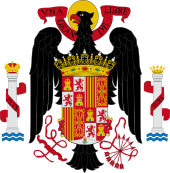Political Reform Act
| Political Reform Act | |
|---|---|
 | |
| Cortes Españolas | |
Long title
| |
| Enacted by | 10th Spanish Constitution of 1978 |
| Status: Repealed | |
The Political Reform Act (Law 1/1977, of 4 January[1]) was the Spanish law that re-established democracy[2] and allowed the elimination of the governmental structures of the Franco dictatorship through a legal process. It is one of the key events in the Spanish Transition.
The Act was passed on 18 November 1976, by the Francoist Parliament and then overwhelmingly approved by referendum one month later. It was the last of the Fundamental Laws of the Francoist State.[3]
Six months later, Spain celebrated its
Background
On 9 October 1976, seven right-wing political parties who
Alianza Popular considered blocking the Bill in order to force the resignation of Prime Minister Adolfo Suárez. However both the Prime Minister and Speaker Torcuato Fernández-Miranda were prepared to dissolve the Cortes Españolas in the event of opposition to the Bill, since the parliamentary term had expired and would need to be extended.[7]
Finally the Bill was approved by the Council of Ministers, it was submitted to the National Council of the Movement and it was approved on 16 October by 80 votes in favor, 13 against and 6 abstentions. The National Council foresaw its own dissolution:
... This bill, which aims and seeks for the popular majority to become the decision-making body of the reform, can only find a legitimate source and basis by incorporating that majority into the current political order...
Content
The Political Reform Act was the legal instrument that allowed the Spanish Transition to be carried out within the legal system established by
The act is divided in five primary articles, three transitory articles (which regulate some legal situations in a provisional way) and a final provision.[1]
- The first two primary articles regulate the form of the state (the King.
- The third and the fourth primary articles regulate the way that the programme of Congress and the Senate.
- The fifth primary article regulates referenda.
- The first transitory article regulates the conduct of elections, the number of deputies and senators and electoral districts.
- The second and the third transitory articles regulate how both legislative chambersare to be constituted and organised, and the rules of conduct of both chambers until the approval of new rules.
A final provision clarifies that the act will have the level of a fundamental law.
Parliamentary process
Since his appointment, prime minister Adolfo Suárez wanted reforms to take place within the existing legal framework through the Francoist Courts, a "democratisation from above" rather than a "democratic break" (ie a constituent assembly and provisional government) demanded by opposition forces.[9] Suarez' UCD party sought and achieved approval of the Bill in the Spanish legislature.
The debate was undertaken over two days from the 16th to the 18th of November.[10] The first member (procurador) of parliament to speak to the Bill was Miguel Primo de Rivera and Urquijo along with Fernando Suárez González, the first representative of the lecture. The next day, 17 November, was the turn of the MPs, who gave arguments in favour and against. On the last day, 18 November, was the government response.
One of the most difficult moments was the intervention of Blas Piñar López against the Bill:
“This reform programme is in conflict with the political philosophy of the State (...), this reform, as the Government wants it, and as the bill argues, is a rupture, although the rupture is to be conducted without violence and with legality.”
The Bill was put to the vote at 09:35 PM of 18 November 1976. It had 425 votes in favour, 59 against, and 13 abstentions.
Referendum

The Act, after being passed by parliament, was submitted to referendum on 18 December 1976. The participation was 77,8% of the census and with a 94,17% votes in favor.[16] [17]
Consequences
The approval of this law is seen as the political transformation of the country, turning Spain into a democracy, with a parliamentary monarchy and with the rule of law as one of the fundamental principles of the State.
This law also gives
See also
- Spanish transition to democracy
- Spanish Constitution of 1978
- Politics of Spain
References
- ^ a b Law 1/1977, of January 4, of the Political Reform Boletín Oficial del Estado. 5 January 1977 (in Spanish).
- OCLC 6555498.
- ^ Mesas, Alberto (19 November 2016). "La ley que obligó al franquismo a suicidarse". cadena SER (in Spanish). Retrieved 23 August 2022.
- ISSN 0015-7120. Retrieved 23 August 2022.
- ISSN 0362-4331. Retrieved 23 August 2022.
- ISSN 1134-6582. Retrieved 23 August 2022.
- ^ Decree 1823/1975, of July 31, which extends the current Legislature of the Spanish Courts. (in Spanish).
- ^ Carr 1980, p. 174.
- ^ Carr 1980, p. 175.
- ^ Manuel Contreras Casado and Enrique Cebrián Zazurca. Law for Political Reform: Memory and Legitimacy at the Beginning of the Spanish Transition to Democracy, pp. 93–102. University of Zaragoza.
- ^ Romero, José Manuel (24 March 2014). "1,670 days that changed Spain". EL PAÍS English Edition. Retrieved 23 August 2022.
- OCLC 870438787.
- ^ "Así se gestó la ley que puso fin al franquismo hace 40 años". ELMUNDO (in Spanish). 20 November 2016. Retrieved 23 August 2022.
- ^ Sevilla, Diario de (17 November 2016). "40 años desde el harakiri". Diario de Sevilla (in European Spanish). Retrieved 23 August 2022.
- ^ "El Congreso se hace el 'harakiri'". Vozpópuli (in Spanish). 29 October 2020. Retrieved 23 August 2022.
- ISBN 978-3-8329-5609-7
- ^ "Spain, 15 December 1976: Political Reform Act". sudd.ch (in German). Direct Democracy. 15 December 1976. Retrieved 1 September 2019.
- ^ "Historia de un Cambio" (in Spanish). Ayuntamiento de Dúrcal. Archived from the original on 28 September 2007.
- ^ La Ley para la Reforma Política (in Spanish).
